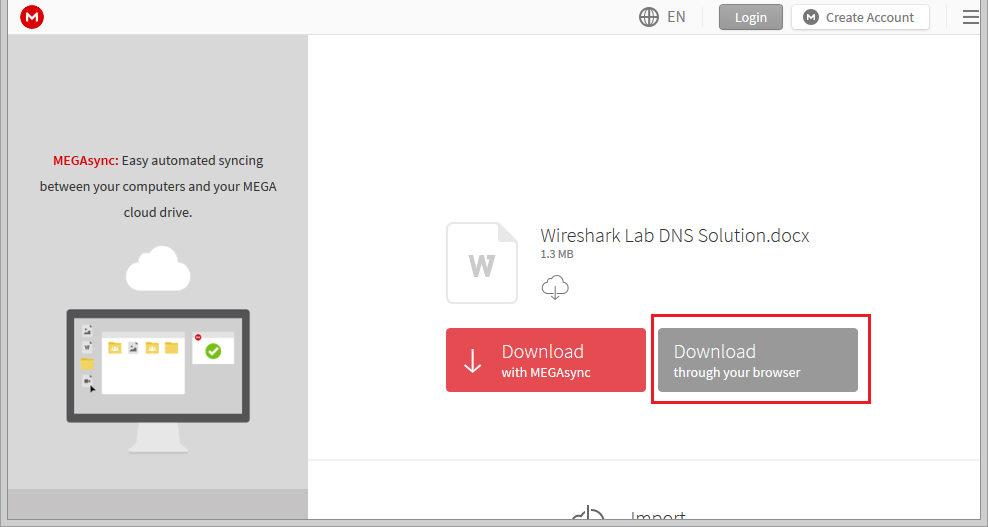Link to download document down below! (Microsoft Word format)
1. Are DHCP messages sent over UDP or TCP?
Answer: DHCP messages are sent over UDP (User Datagram Protocol).
2. Draw a timing datagram illustrating the sequence of the first four-packet Discover/Offer/Request/ACK DHCP exchange between the client and server. For each packet, indicated the source and destination port numbers. Are the port numbers the same as in the example given in this lab assignment?
Answer: The port numbers are the same as the example given in this lab assignment.
3. What is the link-layer (e.g., Ethernet, MAC) address of your host?
Answer: The link-layer address of my host is (00:25:64:e7:3b:2e)
4. What values in the DHCP discover message differentiate this message from the DHCP request message?
Answer: The values which differentiate the Discover message from the Request message are in “Option: (t=53,l=1) DHCP Message Type”
5. What is the value of the Transaction-ID in each of the first four (Discover/Offer/Request/ACK) DHCP messages? What are the values of the Transaction-ID in the second set (Request/ACK) set of DHCP messages? What is the purpose of the Transaction-ID field?
Answer:
Discover - Transaction ID 0x752c8ad1
Offer - Transaction ID 0x752c8ad1
Request - Transaction ID 0x752c8ad1
ACK - Transaction ID 0x752c8ad1

6. A host uses DHCP to obtain an IP address, among other things. But a host’s IP address is not confirmed until the end of the four-message exchange! If the IP address is not set until the end of the four-message exchange, then what values are used in the IP datagrams in the four-message exchange? For each of the four DHCP messages (Discover/Offer/Request/ACK DHCP), indicate the source and destination IP addresses that are carried in the encapsulating IP datagram.
Answer: The DCHP client and server both use 255.255.255.255 as the destination address. The client uses source IP address 0.0.0.0, while the server uses its actual IP address as the source.
7. What is the IP address of your DHCP server?
Answer: The IP address of the DHCP server is 172.18.218.1
8. What IP address is the DHCP server offering to your host in the DHCP Offer message? Indicate which DHCP message contains the offered DHCP address.
Answer: The DHCP server offered the IP address 172.18.218.105 to my client machine. The DHCP message with “DHCP Message Type = DHCP Offer” contained the offered IP.
9. Explain the purpose of the router and subnet mask lines in the DHCP offer message.
Answer: The router line indicates to the client what its default gateway should be. The subnet mask line tells the client which subnet mask it should use.
10. In the example screenshots in this assignment, the host requests the offered IP address in the DHCP Request message. What happens in your own experiment?
Answer: In my experiment, the host requests the offered IP address in the DHCP Request message.
11. Explain the purpose of the lease time. How long is the lease time in your experiment?
Answer: The lease time is the amount of time the DHCP server assigns an IP address to a client. During the lease time, the DHCP server will not assign the IP given to the client to another client, unless it is released by the client. Once the lease time has expired, the IP address can be reused by the DHCP server to give to another client. In my experiment, the lease time is 8 days.
12. What is the purpose of the DHCP release message? Does the DHCP server issue an acknowledgment of receipt of the client’s DHCP request? What would happen if the client’s DHCP release message is lost?
Answer: The client sends a DHCP Release message to cancel its lease on the IP address given to it by the DHCP server. The DHCP server does not send a message back to the client acknowledging the DHCP Release message. If the DHCP Release message from the client is lost, the DHCP server would have to wait until the lease period is over for that IP address until it could reuse it for another client.
Download Link:
How To Download:
Please disable any Ad Block software if any beforehand or this may not work properly.
1. Please wait for 5 seconds.
2. Click on "Skip Ad".
3. Click on "Download through your browser".















































